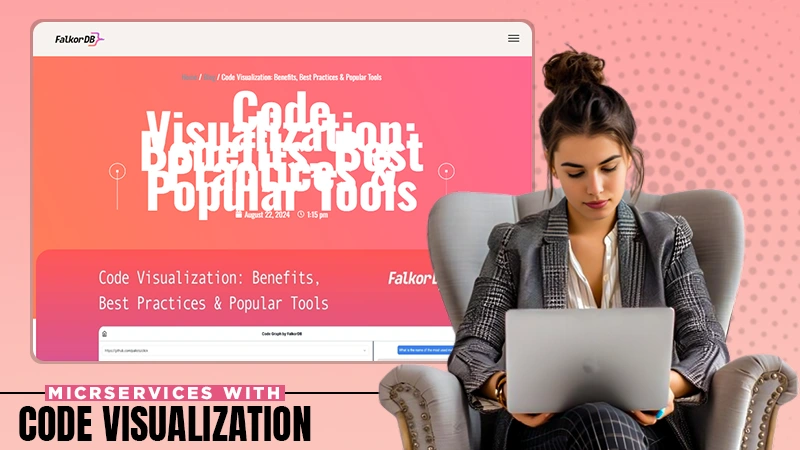Summary: In this Article, you’ll get to read about —
Microservices architecture has become a popular choice for building scalable, distributed systems. However, as microservices grow in complexity, understanding and managing them becomes increasingly challenging. Code visualization can be a powerful tool to simplify microservices, providing a clearer picture of the system, improving communication among teams, and helping with debugging and performance optimization.
Understanding Microservices Complexity
Microservices split apps into smaller, separate services that communicate over the internet. This approach offers benefits like scalability, flexibility, and faster development. However, these advantages also introduce complexity. Unlike monolithic apps, where all components exist in one codebase, microservices are spread across multiple code repositories and servers. This decentralized architecture makes it challenging to track dependencies, manage service interactions, and maintain a clear understanding of the entire system.
Challenges of Microservices Architecture:
- Each service has its own codebase, database, and deployment pipeline.
- Teams often struggle to manage how services interact with one another.
- Logs are distributed across multiple services, complicating debugging.
- Tracing a request through various microservices is a complex task.
- Code visualization tools help mitigate these challenges by offering insights into service relationships and interactions.
How Code Visualization Helps
Code visualization refers to the process of creating graphical representations of your codebase and system architecture. It can range from simple flowcharts and dependency graphs to more sophisticated tools that automatically generate visualizations from your code. For microservices, code visualization can simplify the understanding of service interactions, data flow, and dependencies.
Here’s how code visualization can address specific challenges in microservices:
- Mapping Service Interactions: In a microservices architecture, services often interact with each other in complex ways. Code visualization tools can help map out these interactions, showing which services communicate with each other, the direction of data flow, and the dependencies involved. This high-level view can be invaluable for both developers and system architects.
- Clarifying Dependencies: Microservices often depend on shared libraries, databases, or external services. Visualizing these dependencies helps in understanding the impact of changes and identifying potential bottlenecks or points of failure. A well-crafted dependency graph can also assist in planning updates and refactoring efforts.
- Improving Debugging: Debugging distributed systems is one of the biggest challenges in microservices architecture. Code visualization tools can help trace requests through multiple services, providing a visual trace of the execution path. This can make it easier to identify where errors occur and why.
- Facilitating Onboarding: For new developers joining a project, understanding a microservices-based system can be overwhelming. Code visualization can act as a learning aid, providing a clear picture of the system architecture and service interactions, making it easier for newcomers to get up to speed.
Types of Code Visualization Tools
There are various kinds of code visualization tools you can use in a microservices architecture. These tools are different because they use different methods, from just looking at the code to tracking it as it runs and monitoring it in real-time.
Static Analysis Tools
These tools analyze the source code to create visualizations of the system. They can generate class diagrams, dependency graphs, and architectural overviews. Examples include Structurizr, Graphviz, and PlantUML. These tools are useful for understanding the code structure and identifying dependencies, but they may not provide insights into runtime behavior.
Dynamic Visualization Tools
These tools capture runtime information to provide visualizations of how services interact during execution. Tools like Zipkin and Jaeger are commonly used for distributed tracing, allowing developers to see the flow of requests across microservices. These tools help in understanding the runtime behavior and performance of the system.
Real-Time Monitoring Tools
Monitoring tools like Prometheus and Grafana provide visualizations based on real-time data. They allow you to monitor metrics such as latency, error rates, and throughput, giving you a clear view of the system’s health. While these tools focus more on monitoring than code structure, they are essential for maintaining a robust microservices architecture.
Best Practices for Implementing Code Visualization in Microservices
While code visualization can simplify microservices, it’s important to implement it effectively. Here are some best practices to keep in mind:
- Choose the Right Tools: Not all visualization tools are created equal. Select tools that align with your needs. For example, if you need to understand runtime behavior, focus on dynamic visualization tools and tracing solutions. If your goal is to map dependencies, static analysis tools might be more appropriate.
- Automate Visualization Generation: Manually creating and updating visualizations can be time-consuming and error-prone. Whenever possible, automate the generation of visualizations to ensure they are always up-to-date and accurate. Many tools can automatically generate diagrams based on the current codebase or runtime data.
- Keep Visualizations Focused: Avoid overwhelming your team with overly complex or detailed visualizations. Focus on creating diagrams that are easy to understand and provide the information needed to solve specific problems. Break down large systems into smaller, manageable components.
Conclusion
Simplifying microservices with code visualization is a practical approach to tackling the complexities of distributed systems. By providing a clear and accurate representation of your system architecture, code visualization tools can enhance understanding, improve debugging, and facilitate communication across teams. However, it’s important to choose the right tools, automate where possible, and regularly update your visualizations to keep them relevant. When implemented effectively, code visualization can transform the way you manage and maintain microservices, making your systems more robust and easier to work with.



